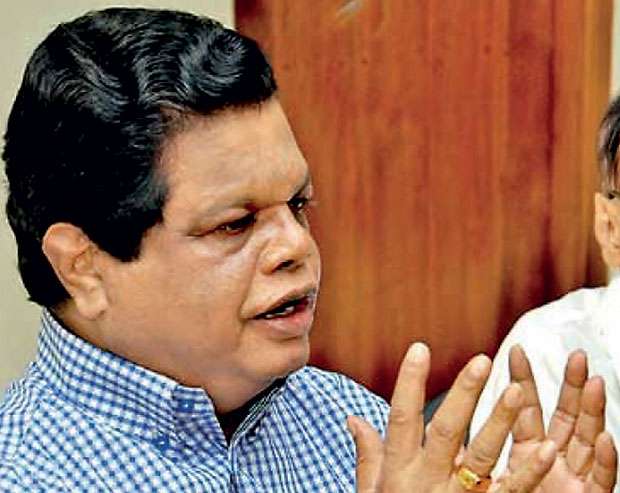11 Jan 2019 - {{hitsCtrl.values.hits}}

 t’s difficult to agree with a person when the point he/she makes is made in a wrong way. And yet, I agree with Bandula Gunawardena. Not because I believe international schools should be shutdown, not because I believe that equating students from these schools with those from government/private schools in terms of examination results is wrong, but because the issue he spoke about makes evident some unpalatable truths about our education system. Where I disagree with his contention, of course, is his remedy. As far as the problem goes, I am with him.
t’s difficult to agree with a person when the point he/she makes is made in a wrong way. And yet, I agree with Bandula Gunawardena. Not because I believe international schools should be shutdown, not because I believe that equating students from these schools with those from government/private schools in terms of examination results is wrong, but because the issue he spoke about makes evident some unpalatable truths about our education system. Where I disagree with his contention, of course, is his remedy. As far as the problem goes, I am with him.
In a context where public schools have put pressure on students and parents, it is natural that an alternative education system should crop up to serve the needs of a specific milieu that has either been excluded from or has grown disillusioned with the public sector. This can be traced to three factors: historical, economic, and social. If we are to dissect the issue, they have to be considered in turn. First and foremost, then, the historical.
Sri Lanka’s education system has mostly run on dualistic lines. When the British brought the country under its rule in 1815, the policy was to prevent the indigenous population from taking part in the administration. Over the years though, thanks to a booming plantation economy, the breakdown of the traditional order, and the need for intermediaries between the elite and locals, this attitude changed, and education, left to the missionaries – the Baptists from 1812, the Wesleyans from 1814, the American Mission from 1816 – was taken up by the government after the Colebrooke-Cameron Reforms, because of which a system was developed to be catered, as J.M. Haward the Director of Public Instruction noted in 1904, to “the higher education of the few” over “the elementary education of the many.” This distinction between the many and the few was an integral part of colonial education policy.
The history of education under British rule can be divided into five periods. Each saw that distinction being maintained one way or the other: between 1796 and 1835, when authorities exhibited an attitude of hostility (as with Governor Barnes) or appeasement (as with Governor Brownrigg) towards missionary schools; between 1835 and 1867, when the government took over the running of certain schools and prioritised English education; between 1867 and 1880, when the Morgan Committee reversed this trend and prioritised the establishment of vernacular schools; between 1880 and 1927, when periods of recession followed by growth were reflected in sudden shifts in policy; and between 1927 and 1948, which culminated with the Report of the Special Committee on Education in 1943 and the Education Ordinance of 1947. Colonialism separated education into two categories: English and vernacular. The elite schools in the country were artificially transplanted from the public school model in England without taking into account local cultural specifics (roughly the same argument made of international schools now), and the outcome was an “accepted policy of vernacular education for the masses and English education for a small elite.” Education policy thus served two needs: the education of an indigenous elite to serve imperial interests, and the education of the rural child to equip him with the “humble career which ordinarily lies before him.”
when authorities exhibited an attitude of hostility (as with Governor Barnes) or appeasement (as with Governor Brownrigg) towards missionary schools; between 1835 and 1867, when the government took over the running of certain schools and prioritised English education; between 1867 and 1880, when the Morgan Committee reversed this trend and prioritised the establishment of vernacular schools; between 1880 and 1927, when periods of recession followed by growth were reflected in sudden shifts in policy; and between 1927 and 1948, which culminated with the Report of the Special Committee on Education in 1943 and the Education Ordinance of 1947. Colonialism separated education into two categories: English and vernacular. The elite schools in the country were artificially transplanted from the public school model in England without taking into account local cultural specifics (roughly the same argument made of international schools now), and the outcome was an “accepted policy of vernacular education for the masses and English education for a small elite.” Education policy thus served two needs: the education of an indigenous elite to serve imperial interests, and the education of the rural child to equip him with the “humble career which ordinarily lies before him.”
The educational divide in the country was geographic and it continues to be reflected in the way academic achievement varies from region to region: in 1883, for instance, average attendance at schools ranged from one in 21 in the Western Province to one in 222 in the North Central Province. From archival documents, we can get an idea as to how legislators viewed and rationalised this rift. Calls had been made since 1799 for an English educated elite to transform the upper echelons of traditional society; over the years English education consequently became the ideal way by which the local elite could capture, retain, and accumulate political power.
By contrast, schools “in the backward rural areas were exclusively vernacular and the rural child had access only to an elementary form of education” (Warnapala 2011: vi). This does not seem to have bothered the colonial administrators: in the 1880s, Bruce’s Revised Education Code, drafted along Lowe’s Revised Education Code of 1860 in England (which codified education for the working class), sought to discourage entry to government English village schools (the mushrooming of which ran counter to the “accepted policy”) by charging high fees and shutting them down whenever there was a missionary school within a distance of two miles (in 1874 the prescribed distance had been three miles; in 1891 it would be brought down to a quarter mile).
Here the antipathy of colonial authorities towards rural schools differed from that of the local elite. In colonial societies like Sri Lanka, where the “national” bourgeoisie never became militant or clashed with these authorities, entry to the bureaucracy or the professions was the ideal path for the bourgeoisie. J.P. Obeyesekere vented out his class interests in this regard when, at the time of the enactment of the Revised Code, he castigated ignorant villagers who got into debt “because of the fastidious notions of their English-educated children” (de Silva 2017: 419). Rural children accordingly had to be schooled to “follow such avocations as they are fitted for by nature.”
 Obeyesekere belonged, of course, to the old elite, but the nouveau riche who would clamour for and get representation in the legislature were no different; to give just one example C.W.W. Kannangara had to clash with D.S. Senanayake over the question of abolishing tuition fees at all levels of education, and had to wait until the latter had gone to Britain in 1945 to obtain the endorsement of the State Council. Senanayake would return in October; Kannangara managed to get the endorsement three months before he did. Nidahas adyapanaya would not, in other words, have seen the light of day with the man hailed today as nidahase piya.
Obeyesekere belonged, of course, to the old elite, but the nouveau riche who would clamour for and get representation in the legislature were no different; to give just one example C.W.W. Kannangara had to clash with D.S. Senanayake over the question of abolishing tuition fees at all levels of education, and had to wait until the latter had gone to Britain in 1945 to obtain the endorsement of the State Council. Senanayake would return in October; Kannangara managed to get the endorsement three months before he did. Nidahas adyapanaya would not, in other words, have seen the light of day with the man hailed today as nidahase piya.
It’s not hard to ascertain why the elite were adamant on maintaining the old divisions between (at the time of the Kannangara reforms) “[government schools and voluntary schools” on the one hand and “English education and vernacular education” on the other hand, because education under colonialism became a marker of the social status of an elite that had already buttressed its economic and political status over the course of several decades. The international school, in that sense, is now the equivalent in a globalised world of the English school that was instituted in a colonised world: the aim of both was, in the words of David Golding, to “transform Sri Lankan culture by privileging the global and marginalising the local.”]
Today, of course, there is nothing “colonial” about our education system. But the distinctions continue. The popular schools (in 1985 there were 18 of these) starve off the less popular schools by dint of the inequalities which persist between the village and the city: as of 2017, less than 10% of schools in here have facilities for science subjects at the A/Levels, and of this number around 32% are national schools; the rest, presumably, are central and provincial schools. The system moreover has enriched the petite bourgeoisie, who have been able to “rise” through free education and the Grade 5 scholarship to popular schools and form a class of their own (a phenomenon that deserves a separate study to itself).
Our education system has broken down due to two disparate yet related forms of differentiation: between the elite and the non-elite sectors in the government system on the one hand, and between the government and private sector on the other. The former form of stratification subsists between the petite bourgeoisie (now the majority occupants of elite schools) and the subaltern (filtered out of those schools) largely as an extension of colonial educational inequalities, while the latter subsists between these two groups and the new urbanised elite, i.e. the present day consumers of private sector secondary education.
This peraliya from the bourgeoisie to the petite bourgeoisie has not been delved into properly, and for me, any discussion of international schools must be prefaced by an at least cursory examination of how elitism in local public schools has shifted from the conservative elite, who railed against educating the rural child, to the children of the gramasevakaya, the polisiye mahaththaya, and the principal of the game iskolaya, who have spawned a new form of social inequality within the system. Colonial class distinctions did not survive free education, but in the absence of a profit motive which automatically separates those who could afford an education from those who could not, the old distinctions had to give way to new; as Tennyson once aptly put it, “The old order changeth, yielding place to new.”
It did yield gradually, so much so that today, even an equitable scheme like the Grade 5 scholarship (which as statistics point out tends to exclude the truly poor student, who rarely sit for the exam) has served to compound these new distinctions against the spirit of free education that, according to the likes of Mr. Gunawardena, is in danger from the proliferation of international schools. The latter problem, of course, cropped up in the eighties; the problems of differentiation in the other schools predate it by as much as three decades. Mr. Gunawardena knows these problems, and, I suspect, only too well. What he does not seem to know is the history behind them.
30 Nov 2024 58 minute ago
30 Nov 2024 3 hours ago
30 Nov 2024 6 hours ago
30 Nov 2024 7 hours ago
29 Nov 2024 29 Nov 2024